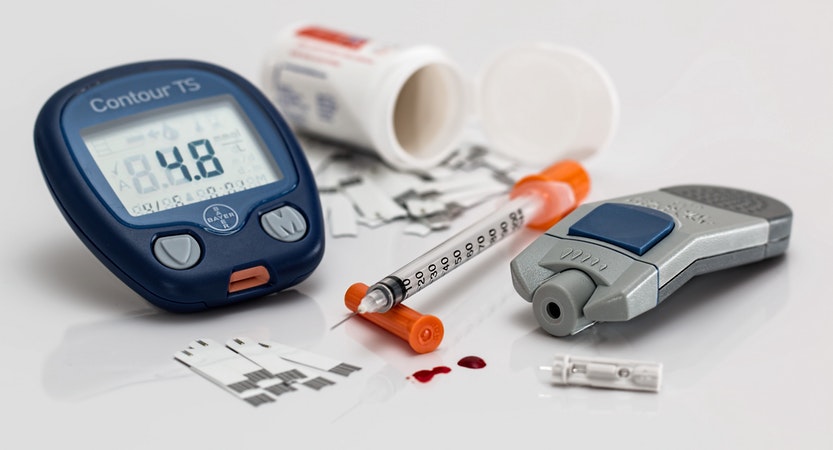What is diabetes mellitus? So, lets find its answer, according to the doctors diabetes is also called diabetes mellitus, It is a group of metabolic diseases in which the person has high blood glucose (blood sugar), due to adequate insulin production or the improper response of body cell to the insulin, eighter or both may be the reason. The person who has high blood sugar experience polyuria (frequent urination), they will become increasingly thirsty (polydipsia) and hungry (polyphagia).
What is Diabetes Mellitus symptoms?
Eye: Blurred Vision
Breath: Acetonic smell
Gastric: Nausea, Abdominal Pain, Vomiting
Urine: Polyuria, Glycosuria
Respiration: Hyperventilations
Systemic: Weight loss
Central Nerves system: Lethargy, Stupor (a state of near-unconsciousness or insensibility), Polydipsia (excessive thirst) and Polyphagia (excessive hunger)
Prediabetes
The vast majority of patients with type 2 diabetes initially had prediabetes. Their blood glucose levels where higher than normal, but not high enough to merit a diabetes diagnosis. The cells in the body are becoming resistant to insulin.
Studies have indicated that even at the prediabetes stage, some damage to the circulatory system and the heart may already have occurred.
There are three types of diabetes Gestational diabetes, Type 1 and Type 2 Diabetes
Gestational diabetes
This type affects females during pregnancy. Some women have very high levels of glucose in their blood, and their bodies are unable to produce enough insulin to transport all of the glucose into their cells, resulting in progressively rising levels of glucose. Diagnosis of gestational diabetes is made during pregnancy.
The majority of gestational diabetes patients can control their diabetes with exercise and diet. Between 10% to 20% of them will need to take some kind of blood-glucose-controlling medications. Undiagnosed or uncontrolled gestational diabetes can raise the risk of complications during childbirth. The baby may be bigger than he/she should be.
Type 1 diabetes
Type-1 diabetes is sometimes called juvenile diabetes, or insulin-dependent diabetes. It means that your body can’t make insulin. Type 1 occurs more frequently in children and young adults but accounts for only 5-10% of the total diabetes cases nationwide.
The body does not produce insulin. Some people may refer to this type as insulin-dependent diabetes, juvenile diabetes, or early-onset diabetes. People usually develop type 1 diabetes before their 40th year, often in early adulthood or teenage years.
Type 1 diabetes is nowhere near as common as type 2 diabetes. Approximately 10% of all diabetes cases are type 1.
Patients with type 1 diabetes will need to take insulin injections for the rest of their life. They must also ensure proper blood-glucose levels by carrying out regular blood tests and following a special diet.
Type 2 diabetes
Type-2 diabetes results when insulin production is defective and tissue resistance to insulin develops. For many persons with Type-2 diabetes, daily insulin supplementation is not required. Diabetes is managed by making moderate changes in diet and exercise.
The body does not produce enough insulin for proper function, or the cells in the body do not react to insulin (insulin resistance).
Approximately 90% of all cases of diabetes worldwide are type 2.
Some people may be able to control their type 2 diabetes symptoms by losing weight, following a healthy diet, doing plenty of exercises, and monitoring their blood glucose levels. However, type 2 diabetes is typically a progressive disease – it gradually gets worse – and the patient will probably end up having to take insulin, usually in tablet form.
Overweight and obese people have a much higher risk of developing type 2 diabetes compared to those with a healthy body weight. People with a lot of visceral fat, also known as central obesity, belly fat, or abdominal obesity, are especially at risk. Being overweight/obese causes the body to release chemicals that can destabilize the body’s cardiovascular and metabolic systems.
The risk of developing type 2 Diabetes Mellitus is also greater as we get older. Experts are not completely sure why, but say that as we age we tend to put on weight and become less physically active. Those with a close relative who had/had type 2 diabetes, people of Middle Eastern, African, or South Asian descent also have a higher risk of developing the disease.
Tests for Diabetes
On the basis of below three tests, the doctor is able to know whether a patient is normal, prediabetic or diabetic.
- The A1C test
– at least 6.5% means diabetes
– between 5.7% and 5.99% means prediabetes
– less than 5.7% means normal - The FPG (fasting plasma glucose) test
– at least 126 mg/dl means diabetes
– between 100 mg/dl and 125.99 mg/dl means prediabetes
– less than 100 mg/dl means normal
An abnormal reading following the FPG means the patient has impaired fasting glucose (IFG) - The OGTT (oral glucose tolerance test)
– at least 200 mg/dl means diabetes
– between 140 and 199.9 mg/dl means prediabetes
– less than 140 mg/dl means normal
An abnormal reading following the OGTT means the patient has impaired glucose tolerance (IGT)
Treatment of Diabetes
All types of diabetes are treatable. Diabetes type-1 lasts a lifetime, there is no known cure. Type 2 also lasts for the lifetime, however, some people have managed to get rid of their symptoms without medication, through a combination of exercise, diet and body weight control.
Patients with type-1 are treated with regular insulin injections, as well as a special diet and exercise.
Patients with Type 2 diabetes are usually treated with tablets, exercise and a special diet, but sometimes insulin injections are also required.
If diabetes is not adequately controlled the patient has a significantly higher risk of developing complications.
Homoeopathy treatment for DIABETES
Homeopathy plays a significant role in the management and sometimes cure of Type 1 and Type 2 Diabetes. However, in most of the cases, the curing process acts very fast. Below I have given the list of homoeopathy medicine which is used for the cure of the types of diabetes.
The most common type of homeopathic medicine for diabetes type 1 is listed below although it greatly helps in reducing the level of blood sugar in type 2.
Syzygium Jambolanum: This is the top homeopathy medicine used for reducing the sugar level.
Syzygium Jambolanum is among the best natural Homeopathic remedies for the treatment of Diabetes Mellitus. It acts promptly and efficiently in decreasing the sugar levels. Excessive thirst and excessive urination are always present in the patient. Homeopathic medicine Syzygium Jambolanum also gives wonderful results in the treatment of long-standing ulcers in a diabetic patient.
“In the present study homeopathic preparations of S. jambolanum and C. indica, including ultramolecular dilutions exhibit antidiabetic effects, improving insulin action through activation of insulin signaling molecules in skeletal muscle of type-2 diabetic rats.” Published in NCBI
Phosphoric Acid: One of the Homeopathic medicines for Diabetes with extreme weakness. According to Boric Materia Medica “The common acid “debility” is very marked in this remedy, producing a nervous exhaustion. Mental debility first; later physical.” Phosphoric Acid is an excellent natural Homeopathic remedy for extreme weakness, either mental or physical, in a diabetic patient. Such patients feel exhausted all the time. Frequent and profuse urination and the frequency increases, especially in the night. Phosphoric Acid is the best Homeopathic remedy.
Abroma Augusta is the top natural Homeopathic medicine to treat Diabetes Mellitus. Its use is highly recommended in those patients who are losing flesh and suffer from extreme weakness due to Diabetes Mellitus. The patients who can greatly benefit from this Homeopathic medicine have an increased thirst with the dryness of mouth. Excessive weakness is felt after urination. It is also great to help in treating sleeplessness in a person with Diabetes. Another sphere in which this Homeopathic remedy yields good results is skin complaints like boils and carbuncles in a diabetic patient.
Phosphorus is a natural Homeopathic medicine of great help in treating Diabetes Mellitus, though its use depends completely on the constitutional symptoms of the patient. Homeopathic medicine Phosphorus is a remedy of great help for the weakness of vision in a diabetic patient. Its also used for Cataract, Sensation as if everything is covered with a mist or veil.
Few other Homeopathic medicined based on Symptoms
Diabetic Retinopathy (damage to eyes due to Diabetes)
Homeopathic medicines Phosphorus, Arnica, Belladonna and Lachesis are equally good natural remedies to deal with eye complaints in diabetic patients. The most suitable Homeopathic medicine out of these is selected on the basis of symptoms described by each patient.
Diabetic Nephropathy (kidney damage due to Diabetes)
Natural Homeopathic medicines that can be very beneficial in the treatment of kidney damage are Lycopodium, Arsenic Album and Serum Anguillae. A complete case history is taken to select the suitable Homeopathic medicine out of these to deal with the kidney complications in diabetic patients. Homoeopathy offers a small supportive role only in this condition and that too in early stages.
Diabetes with Neuropathy (nerve complaints like numbness in hands and feet)
To deal with the problem of numbness in feet and hands due to Diabetes, natural Homeopathic medicines Phosphoric Acid, Sulphur and Helonias are considered the best.
Skin ulcers in diabetic patients
The diabetic skin ulcers are mostly formed on the feet. Natural Homeopathic medicines Syzygium Jambolanum and Secale Cornutum are excellent remedies to deal with ulcers in diabetic patients.
Constipation in diabetic patients
For treating constipation in diabetic patients, Homeopathic medicines Carlsbad, Lac Defloratum and Natrum Sulph top the list. Which of these Homeopathic remedies best suits you is decided after taking note of the individual symptoms.
Weak memory in diabetic patients
To improve the weak memory in patients of Diabetes Mellitus, Kali Phos, Nux Vom and Phosphoric Acid are the natural Homeopathic medicines of great help.
Diabetes Mellitus with extreme weakness
The best natural Homoeopathic medicines to improve the general health of diabetic patients with extreme weakness are Arsenic Album, Phosphorus, Phosphoric Acid and Carbo Veg. Anyone of these Homeopathic remedies can be of great help depending upon the individual symptoms of the patient.
Apart from these Homeopathic treatments for Diabetes Mellitus can also be very effective in treating Erectile Dysfunction, which can be one of the serious consequences of longstanding Diabetes.
This post gives the detailed explanations of what is diabetes mellitus, Type 1 and Type 2 Diabetes, what are the causes of diabetes, type 1 and type 2 diabetes symptoms. For more detailed knowledge about the same please do refer few links which I have provided below. Also, the necessity of a professional doctor is never ignored in case of Diabetes, so before deciding to take any medicine please consult your doctor.
References:
http://www.homeoint.org/books/boericmm/p/ph-ac.htm
http://www.ijrh.org/article.asp?issn=0974-7168;year=2014;volume=8;issue=3;spage=129;epage=135;aulast=Maiti
https://homeoexpert.com/homeopathic-medicine-for-diabetes/
https://treatment.hpathy.com/homeo-medicine/homeopathy-diabetes/
www.drhomeo.com/diabetes/homeopathic-medicines-diabetes
https://www.medicalnewstoday.com/info/diabetes



tadalafil 20 mg
7 Oct 2020It’s really a nice and helpful piece of information. I am glad that you shared this helpful info with us.
Please stay us up to date like this. Thanks for sharing.